蜂蜜生产加工工艺流程与关键质量控制点技术
蜂蜜生产加工工艺流程与关键质量控制点

蜂蜜生产加工工艺流程与关键质量控制点
关键过程/工序: 必要时融蜜、粗滤、脱水
融蜜温度≤65℃,时间50分钟
精滤
120目 温度≤50℃
真空脱水关键参数:0.092MPa 温度≤55℃
蜂蜜生产加工前预处理过程关键质量控制
1、原材料的验收
采用未经添加任何物质的纯天然优质蜂蜜作为生产原料,该原料要未经任何污染,并严格按照GBl4963—2011蜂蜜国家强制性标准或GB/Tl8796—2012要求进行抽样检测,其检测项目为波美度、果糖、葡萄糖(还原糖)、含水量、蔗糖、酶值、羟甲基糠醛等,符合标准并高于标准要求的合格产品方能入库。
2、包装物清洗与灭菌
仓库贮藏用包装物严格按生产工艺要求先用清水清洗不干净附着物,然后采用浓度为0.5%的84消毒液洗洁精浸泡包装容器40分钟以上、清水漂洗2次、清水冲洗2次,以保证生产环境及生产过程中使用的包装容器无菌。
用于分装的小包装玻璃瓶及瓶盖严格按要求用清水洗去不干净附着物,然后采用浓度为0.5%的84消毒液浸泡包装瓶45分钟、清水漂洗1次、清水冲洗2次,再用紫外线照射2-4小时进行消毒,确保小包装产品出厂合格,符合国家有关食品包装卫生要求。
3、生产人员进入生产车间分装室前必须用0.2%的84消毒液进行消毒洗手或洗手后用75%酒精消毒,穿戴经过灭菌的工作鞋、帽、工作服后,才能进入分装室进行分装生产,确保分装室无污染。
蜂蜜生产实施方案

蜂蜜生产实施方案蜂蜜是一种天然的营养食品,具有丰富的营养成分和独特的药用价值,受到了越来越多消费者的青睐。
为了提高蜂蜜的生产效率和质量,制定一套科学的生产实施方案显得尤为重要。
本文将就蜂蜜生产的实施方案进行详细的阐述,希望对广大蜂蜜生产从业者有所帮助。
一、蜂蜜生产的基本流程。
蜂蜜的生产主要包括采蜜、提取蜜、过滤、储存等几个基本环节。
首先,要选择适宜的蜜源地,保证采蜜的原料充足且质量优良。
其次,采蜜要选择适当的时间和气候条件,避免对蜜蜂产生不良影响。
在提取蜜的过程中,要注意保持卫生,避免杂质的混入。
最后,提取的蜜需要进行过滤和储存,确保蜜的质量和口感。
二、蜂蜜生产的关键技术。
1. 蜂箱管理。
蜂箱是蜜蜂生产蜂蜜的重要场所,蜂箱的管理对蜂蜜的产量和质量有着直接的影响。
要定期对蜂箱进行检查和清洁,保持蜂箱的整洁和通风。
及时更换老化的蜂箱,保证蜜蜂的生长环境。
2. 采蜜技术。
采蜜是蜜蜂生产蜂蜜的关键环节,采蜜技术的好坏直接决定了蜂蜜的产量和质量。
在采蜜过程中,要注意不伤害蜜蜂,避免对蜜蜂群的影响。
选择适当的采蜜工具和方法,确保采蜜的效率和安全。
3. 蜜蜂饲养。
蜜蜂的饲养对蜂蜜的生产至关重要,要合理安排蜜蜂的饲养时间和饲料类型,保证蜜蜂的生长和繁殖。
定期对蜜蜂进行检查和防疫,确保蜜蜂的健康和生长。
三、蜂蜜生产的质量控制。
蜂蜜的质量是直接关系到消费者的健康和对产品的信任度。
要严格按照国家标准进行生产,确保蜂蜜的质量符合相关标准。
在生产过程中,要注意保持生产场所的卫生和整洁,避免杂质的混入。
对蜂蜜进行定期的质量检测,确保产品的安全和可靠。
四、蜂蜜生产的市场营销。
蜂蜜的市场需求量大,但竞争也很激烈,如何进行有效的市场营销成为了蜂蜜生产者需要重点关注的问题。
要根据市场需求,制定合理的价格和销售策略,开拓新的销售渠道,提高产品的知名度和美誉度。
同时,要注意保护好自己的品牌形象,提高产品的附加值和竞争力。
综上所述,蜂蜜生产实施方案需要从生产流程、关键技术、质量控制和市场营销等多个方面进行全面考虑和规划。
蜜蜂蜂蜜加工技术
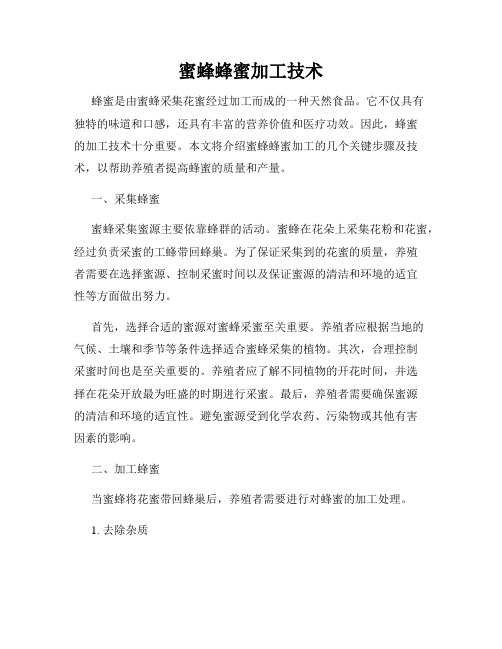
蜜蜂蜂蜜加工技术蜂蜜是由蜜蜂采集花蜜经过加工而成的一种天然食品。
它不仅具有独特的味道和口感,还具有丰富的营养价值和医疗功效。
因此,蜂蜜的加工技术十分重要。
本文将介绍蜜蜂蜂蜜加工的几个关键步骤及技术,以帮助养殖者提高蜂蜜的质量和产量。
一、采集蜂蜜蜜蜂采集蜜源主要依靠蜂群的活动。
蜜蜂在花朵上采集花粉和花蜜,经过负责采蜜的工蜂带回蜂巢。
为了保证采集到的花蜜的质量,养殖者需要在选择蜜源、控制采蜜时间以及保证蜜源的清洁和环境的适宜性等方面做出努力。
首先,选择合适的蜜源对蜜蜂采蜜至关重要。
养殖者应根据当地的气候、土壤和季节等条件选择适合蜜蜂采集的植物。
其次,合理控制采蜜时间也是至关重要的。
养殖者应了解不同植物的开花时间,并选择在花朵开放最为旺盛的时期进行采蜜。
最后,养殖者需要确保蜜源的清洁和环境的适宜性。
避免蜜源受到化学农药、污染物或其他有害因素的影响。
二、加工蜂蜜当蜜蜂将花蜜带回蜂巢后,养殖者需要进行对蜂蜜的加工处理。
1. 去除杂质蜜蜂将花蜜放入蜂巢后,其中可能会含有一些杂质,例如花粉、昆虫残体、蜂翅等。
因此,在进行下一步加工前,需要将这些杂质去除。
通常的方法是利用蜂巢本身的构造及蜜蜂运动的特点,让蜜蜂将杂质上浮并飞出蜂巢。
2. 蜂蜜分离蜜蜂将花蜜放入蜂巢后,其中可能会有一些蜂蜡。
为了将蜂蜜与蜂蜡分离开来,养殖者需要进行蜂蜜的离心分离。
通常使用离心机将蜂蜜分离出来,离心过程中蜂蜡会被离心到一定高度,然后可以采取合适的方法将蜂蜜从离心机中取出。
3. 过滤为了进一步提高蜂蜜的质量,养殖者需要对蜂蜜进行过滤。
过滤的目的是去除蜂蜜中的微小颗粒、杂质以及蜂蜡残留等物质。
通常可以使用滤网或者纱布等过滤蜂蜜,并重复过滤以确保蜂蜜的纯净度。
4. 蜂蜜贮存蜂蜜加工完毕后,养殖者需要将蜂蜜储存起来。
一般来说,蜂蜜应该储存在无光、无味的容器中,以保持其纯净度和口感。
储存环境应保持干燥、阴凉、避光,以免蜂蜜变质。
同时,养殖者还可以根据需要选择适当的包装方式,以延长蜂蜜的贮存期限。
蜜蜂蜂蜜加工工艺技术大全

蜜蜂蜂蜜加工工艺技术大全蜂蜜是一种美味健康的食品,具有丰富的营养成分和药用价值。
蜂蜜的加工工艺技术对于保证蜂蜜品质的稳定和提高蜂蜜的附加值具有重要意义。
本文将介绍蜜蜂蜂蜜加工工艺技术的大全,以帮助加工商和消费者更好地了解和利用蜂蜜的价值。
一、蜂蜜基本加工工艺1.采集蜜蜂蜂蜜的工艺蜜蜂蜂蜜的采集是整个加工工艺的起点。
一般来说,采集蜜蜂蜂蜜的时间应选择在蜜蜂盛产蜂蜜的季节,如春季和夏季。
采集的方法可以采用手工采集或机械采集,手工采集一般适用于规模较小的养蜂场,而机械采集则适用于规模较大的养蜂场。
2.蜂蜜过滤工艺蜂蜜在采集完成后需要进行过滤。
过滤的目的是去除蜂蜜中的杂质,如蜂翅、蜂蜜渣等,以提高蜂蜜的纯度。
过滤的方法可以采用简单的滤网过滤或者高级的离心过滤。
3.蜂蜜储存工艺过滤后的蜂蜜需要进行储存。
蜂蜜储存时应注意避免阳光直射和高温环境,最好放置在阴凉通风的地方。
同时,应保持容器的密封性,避免蜂蜜受潮和蜜蜂等污染。
二、蜂蜜深加工工艺蜂蜜酿造是一种利用蜂蜜作为发酵基质制作酒类产品的工艺。
这种工艺可以生产出口味独特的蜂蜜酒,如蜂蜜葡萄酒、蜂蜜啤酒等。
在蜂蜜酿造过程中,需要控制发酵时间和温度,以便获得更好的口感和质量。
2.蜂蜜制作蜜糖技术蜜糖是一种由蜂蜜为主要原料制作而成的糖类产品。
蜜糖制作的关键是蜂蜜的结晶,通过控制结晶的条件和时间,可以获得不同口感和品质的蜜糖产品。
蜜糖制作工艺一般包括溶解蜂蜜、结晶蜜糖、包装等步骤。
3.蜂蜜制作蜜饯技术蜜饯是一种利用蜂蜜作为主要原料制作而成的果蔬干燥制品。
蜜饯的制作过程包括蜜化、脱水、烘干等环节。
其中,蜜化是将蜂蜜与食材充分混合,使其吸收蜂蜜的味道和营养成分,然后经过脱水和烘干处理,最终制成蜜饯产品。
4.蜂蜜制作美容护肤品技术蜂蜜具有很好的保湿、修复和抗菌功效,因此广泛应用于美容护肤品的制作中。
常见的蜂蜜护肤品有蜜蜂蜂蜜面膜、蜜蜂蜂蜜洁面乳等。
制作美容护肤品时,可以将蜂蜜与其他有效成分进行混合,以增强其护肤效果。
蜂蜜的加工与品质保障技术养蜂技术大全
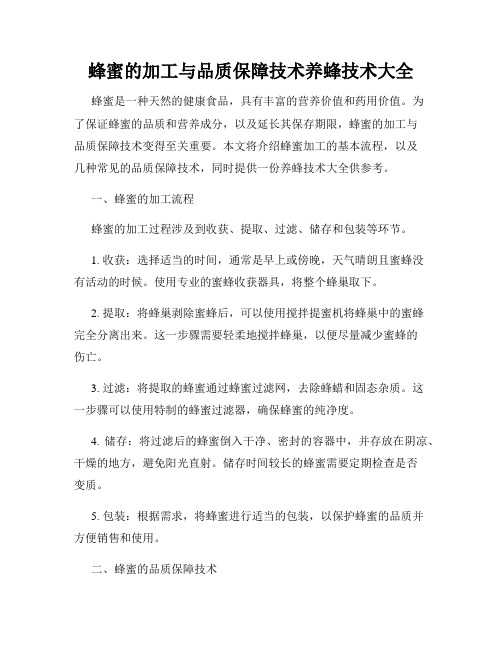
蜂蜜的加工与品质保障技术养蜂技术大全蜂蜜是一种天然的健康食品,具有丰富的营养价值和药用价值。
为了保证蜂蜜的品质和营养成分,以及延长其保存期限,蜂蜜的加工与品质保障技术变得至关重要。
本文将介绍蜂蜜加工的基本流程,以及几种常见的品质保障技术,同时提供一份养蜂技术大全供参考。
一、蜂蜜的加工流程蜂蜜的加工过程涉及到收获、提取、过滤、储存和包装等环节。
1. 收获:选择适当的时间,通常是早上或傍晚,天气晴朗且蜜蜂没有活动的时候。
使用专业的蜜蜂收获器具,将整个蜂巢取下。
2. 提取:将蜂巢剥除蜜蜂后,可以使用搅拌提蜜机将蜂巢中的蜜蜂完全分离出来。
这一步骤需要轻柔地搅拌蜂巢,以便尽量减少蜜蜂的伤亡。
3. 过滤:将提取的蜂蜜通过蜂蜜过滤网,去除蜂蜡和固态杂质。
这一步骤可以使用特制的蜂蜜过滤器,确保蜂蜜的纯净度。
4. 储存:将过滤后的蜂蜜倒入干净、密封的容器中,并存放在阴凉、干燥的地方,避免阳光直射。
储存时间较长的蜂蜜需要定期检查是否变质。
5. 包装:根据需求,将蜂蜜进行适当的包装,以保护蜂蜜的品质并方便销售和使用。
二、蜂蜜的品质保障技术为了确保蜂蜜的原始品质和防止酸化变质,人们发展了多种品质保障技术。
1. 低温贮存技术:通过将蜂蜜储存于低温环境下,可以延长蜂蜜的保存期限,并减少微生物的繁殖。
一般建议将蜂蜜贮存在0°C至10°C 的环境中。
2. 灭菌处理技术:在蜂蜜加工过程中,可以使用高温或者紫外线辐射等方法对蜂蜜进行灭菌处理,以杀死可能存在的微生物。
但是需要注意的是,过高的温度可能会破坏蜂蜜的营养成分。
3. 蜜源环境监测技术:蜜源环境监测可以检测到花粉和农药等污染物质的存在,从而保证蜂蜜的品质。
通过合理选择蜜源地,并采取有效的监测方法,可以减少蜂蜜受到环境污染的可能。
4. 包装设计技术:蜂蜜的包装除了要美观大方,还要具备保护蜂蜜的功能。
合理的包装设计可以防止蜂蜜受到氧化和湿气的影响,从而保证蜂蜜的品质。
蜜蜂蜂蜜生产流程控制技术大全

蜜蜂蜂蜜生产流程控制技术大全蜂蜜是一种天然的甜味食品,具有丰富的营养价值和药用价值。
蜂蜜的生产过程需要严格控制,涉及到蜜蜂的采集、蜜蜂巢的管理、蜜蜂繁殖等多个环节。
本文将介绍蜂蜜生产的全过程,并探讨蜂蜜生产流程控制技术。
一、采集蜜蜂蜜蜂采集蜂蜜是蜂蜜生产的第一步。
通常,蜜蜂会从花蕊中吸取花蜜,然后储存在蜂巢的蜂房中。
蜜蜂巢有助于蜜蜂收集足够数量的蜂蜜。
在采集蜜蜂时,需要注意以下几点:1. 确定采集的时机:蜜蜂在特定的季节和天气条件下采集蜂蜜,一般集中在春季和夏季。
蜜蜂采集蜂蜜的能力会受到天气因素的影响,如温度和湿度。
因此,要合理安排采集的时机,以便获得高质量的蜂蜜。
2. 选择合适的蜜源:蜜蜂采集蜂蜜需要有可靠的蜜源供应。
通常,花粉丰富的花卉是蜜蜂采集蜂蜜的理想选择。
各种不同类型的花蜜会影响蜜蜂蜂蜜的口味和颜色。
因此,在选择蜜源时,要根据需要的蜂蜜品种和质量要求进行选择。
二、管理蜂巢蜜蜂巢是生产蜂蜜的关键环节之一。
管理蜂巢需要保证蜜蜂的生长和繁殖环境,以及蜂巢的健康和安全。
以下是管理蜂巢的一些建议:1. 维持蜂巢的卫生:蜜蜂巢的卫生状况直接影响蜂蜜的质量。
定期检查蜂巢的卫生情况,清理残渣和死蜂,防止疾病和虫害的侵袭。
2. 适应蜜蜂繁殖:蜂巢需要提供合适的环境来促进蜜蜂的繁殖。
为蜜蜂提供足够数量的巢室和足够的花粉和蜂蜜供应,以满足蜜蜂的生长和繁殖需求。
三、提取蜂蜜蜂蜜的提取是蜜蜂生产流程中的关键一步。
提取蜂蜜需要采用适当的技术和设备,以保持蜂蜜的质量和口感。
以下是一些提取蜂蜜的技术要点:1. 蜂蜜提取设备:蜂蜜提取设备包括蜂蜜离心机、过滤器、储存容器等。
离心机通过离心力将蜜蜂蜂蜜与蜂蜜巢分离,过滤器用于去除杂质,储存容器用于储存蜂蜜。
2. 控制提取温度:提取蜂蜜时要控制提取温度,避免过高温度对蜂蜜的质量造成不良影响。
通常,提取温度不超过40摄氏度。
四、蜜蜂蜂蜜质量控制蜜蜂蜂蜜的质量控制是蜜蜂生产流程中的重要环节之一。
蜜蜂蜂蜜蜂蜜质量控制技术大全
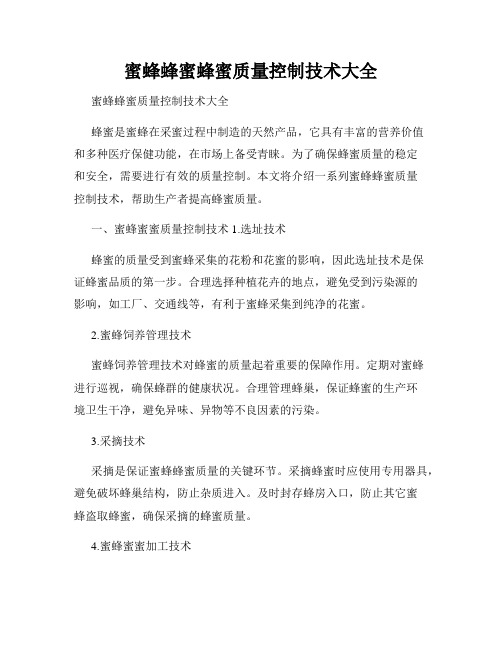
蜜蜂蜂蜜蜂蜜质量控制技术大全蜜蜂蜂蜜质量控制技术大全蜂蜜是蜜蜂在采蜜过程中制造的天然产品,它具有丰富的营养价值和多种医疗保健功能,在市场上备受青睐。
为了确保蜂蜜质量的稳定和安全,需要进行有效的质量控制。
本文将介绍一系列蜜蜂蜂蜜质量控制技术,帮助生产者提高蜂蜜质量。
一、蜜蜂蜜蜜质量控制技术1.选址技术蜂蜜的质量受到蜜蜂采集的花粉和花蜜的影响,因此选址技术是保证蜂蜜品质的第一步。
合理选择种植花卉的地点,避免受到污染源的影响,如工厂、交通线等,有利于蜜蜂采集到纯净的花蜜。
2.蜜蜂饲养管理技术蜜蜂饲养管理技术对蜂蜜的质量起着重要的保障作用。
定期对蜜蜂进行巡视,确保蜂群的健康状况。
合理管理蜂巢,保证蜂蜜的生产环境卫生干净,避免异味、异物等不良因素的污染。
3.采摘技术采摘是保证蜜蜂蜂蜜质量的关键环节。
采摘蜂蜜时应使用专用器具,避免破坏蜂巢结构,防止杂质进入。
及时封存蜂房入口,防止其它蜜蜂盗取蜂蜜,确保采摘的蜂蜜质量。
4.蜜蜂蜜蜜加工技术蜜蜂蜜蜜加工技术直接影响到蜂蜜的品质。
采用绿色、环保的加工设备、用具,避免蜂蜜与有害物质接触,防止蜜蜂蜜蜜的氧化和变质。
合理控制蜂蜜的温度,避免高温条件下蜂蜜的流失和营养价值的破坏。
5.蜜蜂蜜蜜储存技术储存环境对蜜蜜的质量有着重要影响。
蜜蜜应储存在干燥、通风、清洁、无异味的环境中,避免日光直射和高温环境。
储存容器应使用无毒、无味的食品级材料,避免化学物质对蜂蜜的污染。
6.蜜蜂蜜蜜检验技术蜜蜂蜜蜜的质量检验是保证产品质量的重要手段。
可以通过外观、气味、味道等感官指标进行初步检验。
同时还可以应用先进的分析仪器,检测蜜蜜的水分含量、糖含量、酸度等关键指标,确保蜂蜜的质量符合标准。
7.质量追溯技术质量追溯技术可以追踪蜜蜜的生产、加工、存储环境以及运输路径等信息,一旦发现问题可以进行追溯,以便及时采取措施,保证产品质量和消费者权益。
结语蜜蜂蜂蜜质量控制技术的实施,有助于确保蜂蜜的品质和安全。
蜜蜂蜂蜜加工与产品开发技术大全
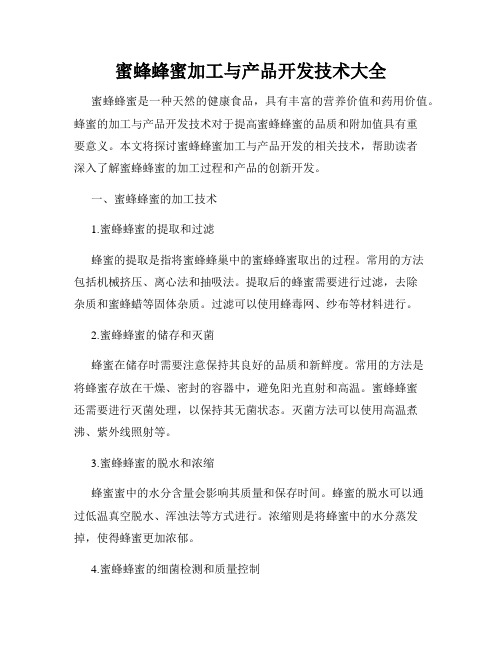
蜜蜂蜂蜜加工与产品开发技术大全蜜蜂蜂蜜是一种天然的健康食品,具有丰富的营养价值和药用价值。
蜂蜜的加工与产品开发技术对于提高蜜蜂蜂蜜的品质和附加值具有重要意义。
本文将探讨蜜蜂蜂蜜加工与产品开发的相关技术,帮助读者深入了解蜜蜂蜂蜜的加工过程和产品的创新开发。
一、蜜蜂蜂蜜的加工技术1.蜜蜂蜂蜜的提取和过滤蜂蜜的提取是指将蜜蜂蜂巢中的蜜蜂蜂蜜取出的过程。
常用的方法包括机械挤压、离心法和抽吸法。
提取后的蜂蜜需要进行过滤,去除杂质和蜜蜂蜡等固体杂质。
过滤可以使用蜂毒网、纱布等材料进行。
2.蜜蜂蜂蜜的储存和灭菌蜂蜜在储存时需要注意保持其良好的品质和新鲜度。
常用的方法是将蜂蜜存放在干燥、密封的容器中,避免阳光直射和高温。
蜜蜂蜂蜜还需要进行灭菌处理,以保持其无菌状态。
灭菌方法可以使用高温煮沸、紫外线照射等。
3.蜜蜂蜂蜜的脱水和浓缩蜂蜜蜜中的水分含量会影响其质量和保存时间。
蜂蜜的脱水可以通过低温真空脱水、浑浊法等方式进行。
浓缩则是将蜂蜜中的水分蒸发掉,使得蜂蜜更加浓郁。
4.蜜蜂蜂蜜的细菌检测和质量控制蜜蜂蜂蜜的质量与其细菌污染程度密切相关。
通过对蜂蜜进行细菌检测,可以确保蜂蜜的安全性和卫生质量。
常用的检测方法包括菌落计数法、胶皿法和酶标法等。
此外,还需要进行蜜蜂蜂蜜的物理、化学指标的检测,以控制产品质量。
二、蜜蜂蜂蜜产品的开发技术1.蜜蜂蜂蜜饮品的开发蜂蜜可用于开发各种营养饮品,如蜂蜜柚子茶、蜂蜜草莓奶昔等。
通过将蜜蜂蜂蜜与其他食材进行混合,可以制作出口感丰富、口味独特的蜂蜜饮品。
2.蜜蜂蜂蜜保健品的开发蜂蜜具有很好的保健功效,可用于开发蜂蜜保健品。
蜂蜜保健品可以针对不同的人群需求进行开发,如蜂蜜饮片、蜂王浆软胶囊等。
3.蜜蜂蜂蜜糕点的开发蜜蜂蜂蜜可以与面粉、牛奶等材料搭配,制作出各种蜜蜜糕点,如蜂蜜松饼、蜂蜜糖饼等。
蜜蜂蜂蜜的加入不仅能增加糕点的口感,还能给糕点带来独特的风味。
4.蜜蜂蜂蜜化妆品的开发蜜蜂蜂蜜富含多种维生素和氨基酸,具有很好的保湿和滋养功效,可用于开发蜜蜜化妆品,如蜂蜜面膜、蜂蜜护发素等。
蜂蜜生产加工工艺流程与关键质量控制点技术

英文回答:Honey production processing processes and key quality control point technologies are important links in agricultural production and are important for safeguarding the quality of honey products and promoting the development of agro—processing industries。
We must insist on science and technology to lead agricultural production, strengthen quality management, and strictly close key processes to ensure that honey products are eligible to meet national standards and quality requirements。
There is a need to strengthen regulation and policy support to promote the sustainable and healthy development of the honey industry and to provide strong support for farmers to grow wealth and promote rural renewal。
蜂蜜的生产加工工艺流程及关键质量控制点技术是农业生产中的重要环节,对于保障蜂蜜产品质量、促进农产品加工产业发展具有重要意义。
我们必须坚持科学技术引领农业生产,加强质量管理,严格把关关键工艺环节,确保蜂蜜产品合格,达到国家标准和质量要求。
蜂蜜生产流程控制技术大全

蜂蜜生产流程控制技术大全蜂蜜是一种天然、营养丰富且味道甜美的食品。
它不仅被广泛应用于食品行业,还被用于医学和化妆品制造等领域。
为了确保生产出高质量的蜂蜜,在生产过程中需要进行严格的流程控制。
本文将详细介绍蜂蜜生产流程控制的技术方法。
一、蜜源选择与管理蜂蜜的质量与蜜源密切相关。
不同的蜜源产生的蜂蜜味道、颜色和营养成分都有所不同。
因此,在生产过程中,需要选择适当的蜜源,并对蜜源进行管理。
蜜源管理包括保护蜜源环境、控制蜂群健康状况等方面。
只有保证蜜源的优质和稳定,才能生产出优质的蜂蜜。
二、采蜜与挤蜜采蜜是蜂蜜生产的第一步。
传统的采蜜方式是人工采蜜,现代化的采蜜方式是使用蜜蜂采蜜机进行自动采蜜。
采蜜时需要选择适当的蜜刺,控制时间和频率,以免对蜜蜂造成伤害。
挤蜜是将采集到的蜜蜂蜜进行提取的步骤。
在挤蜜过程中,需要合理控制蜜蜂蜜的温度和压力,以保持其原有的品质。
三、蜂蜜过滤与澄清蜂蜜中可能会含有蜂蜡、蜜蜂残骸、杂质等不容许出现的物质。
因此,在生产过程中,需要对蜂蜜进行过滤与澄清。
过滤是通过不同孔径的过滤网将蜂蜜中的杂质去除。
澄清是指通过沉淀和去泡处理,使蜂蜜澄清透明。
过滤和澄清操作需要严格控制时间和温度,以不影响蜂蜜的品质。
四、蜂蜜加热与杀菌蜂蜜的加热和杀菌是为了消除其中的微生物和酵母菌,并延长蜂蜜的保质期。
加热温度和时间是控制蜂蜜加热杀菌的重要参数。
一般情况下,加热温度应在50℃-70℃之间,加热时间不宜过长,以免对蜂蜜的原有成分造成损害。
五、蜂蜜贮存与包装蜂蜜贮存和包装也是确保蜂蜜质量的重要环节。
蜂蜜贮存时应注意防潮、防晒和避免与异味物质接触。
包装时,要选择符合国家标准的食品级容器,并确保密封性能良好。
此外,包装材料不应对蜂蜜产生化学反应,以避免污染。
通过实施上述的蜂蜜生产流程控制技术,可以确保蜂蜜生产的质量和安全性。
生产者应严格遵循相关标准和规范,保证每一道工序的操作规范和准确性。
只有这样,才能生产出符合需求的出色蜂蜜产品。
蜂蜜的提取工艺与质量控制
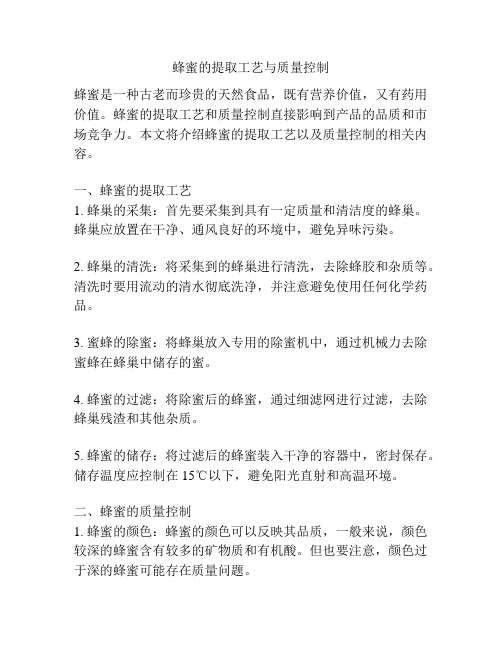
蜂蜜的提取工艺与质量控制蜂蜜是一种古老而珍贵的天然食品,既有营养价值,又有药用价值。
蜂蜜的提取工艺和质量控制直接影响到产品的品质和市场竞争力。
本文将介绍蜂蜜的提取工艺以及质量控制的相关内容。
一、蜂蜜的提取工艺1. 蜂巢的采集:首先要采集到具有一定质量和清洁度的蜂巢。
蜂巢应放置在干净、通风良好的环境中,避免异味污染。
2. 蜂巢的清洗:将采集到的蜂巢进行清洗,去除蜂胶和杂质等。
清洗时要用流动的清水彻底洗净,并注意避免使用任何化学药品。
3. 蜜蜂的除蜜:将蜂巢放入专用的除蜜机中,通过机械力去除蜜蜂在蜂巢中储存的蜜。
4. 蜂蜜的过滤:将除蜜后的蜂蜜,通过细滤网进行过滤,去除蜂巢残渣和其他杂质。
5. 蜂蜜的储存:将过滤后的蜂蜜装入干净的容器中,密封保存。
储存温度应控制在15℃以下,避免阳光直射和高温环境。
二、蜂蜜的质量控制1. 蜂蜜的颜色:蜂蜜的颜色可以反映其品质,一般来说,颜色较深的蜂蜜含有较多的矿物质和有机酸。
但也要注意,颜色过于深的蜂蜜可能存在质量问题。
2. 蜂蜜的味道:蜂蜜的味道应该甜润纯正,没有任何异味。
如果蜂蜜带有酸味、涩味或其他异味,可能说明蜂蜜发酵或受污染了。
3. 蜂蜜的含水量:蜂蜜的含水量高低与其质量密切相关。
过高的含水量容易导致蜂蜜变质,而过低的含水量则可能使蜂蜜结晶。
4. 蜂蜜的酸值:蜂蜜的酸度可以通过测定酸值来评价。
酸值过高可能说明蜂蜜不新鲜或质量不佳。
5. 蜂蜜的氢氧离子浓度(pH值):蜂蜜的pH值对其品质有影响,一般来说,pH值越低,蜂蜜越酸,细菌和微生物生长也会受到抑制。
6. 蜂蜜的糖分组成:蜂蜜主要由葡萄糖和果糖组成,蜂蜜的糖分组成也直接影响其口感和品质。
7. 蜂蜜的氧化稳定性:蜂蜜易受到氧化的影响,氧化会导致蜂蜜变质和失去营养价值。
因此,蜂蜜应储存在密封的容器中,避免暴露在空气中。
总之,蜂蜜的提取工艺和质量控制是保证产品品质的重要环节。
只有通过严格的工艺流程和质量控制,才能生产出优质的蜂蜜产品。
蜂蜜产品的品质控制技术大全

蜂蜜产品的品质控制技术大全蜂蜜一直以来都是人们喜爱的天然食品,除了其甜美的味道之外,它还具备许多健康的功效。
然而,市场上存在着各种质量参差不齐的蜂蜜产品。
为了确保消费者能够购买到高品质的蜂蜜产品,厂商需要运用有效的品质控制技术。
本文将介绍蜂蜜产品的品质控制技术大全,以帮助厂商提高产品质量,满足市场需求。
一、原材料选择与采购蜂蜜产品的质量直接受到原材料的影响,因此,厂商应该选择高品质的蜂蜜原材料。
首先,要选择来自健康蜜蜂群的蜂蜜,避免受到植物农药、重金属等污染的蜂蜜。
其次,要选择产自有良好生产环境的蜜蜂养殖场的蜂蜜原材料,确保其纯度和卫生安全。
二、生产设备与工艺控制为了生产出高品质的蜂蜜产品,厂商需要使用先进的生产设备,并确保设备的清洁和无菌。
在生产过程中,应该严格控制温度、湿度、压力等参数,以确保蜂蜜的质量稳定。
同时,要采用科学的生产工艺,如低温提取、分离等技术,以保留蜂蜜中的有益成分。
三、蜂蜜检测与分析为了保证蜂蜜产品的质量,厂商需要建立完善的蜂蜜检测与分析体系。
首先,要对进货原材料进行化学成分和微生物指标的检测,确保其符合国家卫生标准。
其次,在生产过程中,要进行常规的质量检测,包括酸值、水分、氨基酸等指标的检测。
最后,在产品出厂前,要进行全面的理化指标和微生物指标的检测,确保产品的质量稳定。
四、包装与储存控制包装是蜂蜜产品质量控制的重要环节之一。
厂商应该选择安全卫生的包装材料,并遵循标准的包装流程,确保蜂蜜产品在包装过程中不受到污染。
同时,要对包装进行严格的外观检查,确保产品的外观美观。
在储存过程中,厂商要注意控制温度和湿度,避免产品变质和发酵。
五、质量管理与追溯体系为了确保蜂蜜产品质量的持续改进,厂商需要建立完善的质量管理与追溯体系。
首先,要制定完善的质量管理制度和工作流程,明确各个环节的责任和要求。
其次,要进行定期的内部质量审核和外部质量认证,以确保产品的合规性和标准化。
最后,要建立追溯体系,追踪产品的生产过程和销售渠道,方便问题的排查和解决。
蜂蜜产品质量控制技术大全
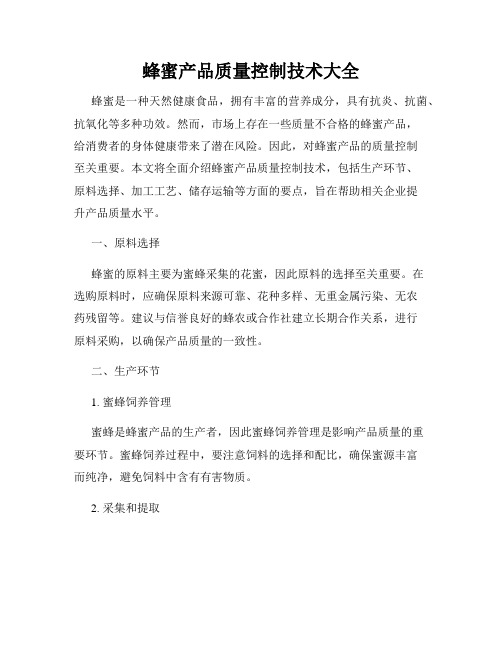
蜂蜜产品质量控制技术大全蜂蜜是一种天然健康食品,拥有丰富的营养成分,具有抗炎、抗菌、抗氧化等多种功效。
然而,市场上存在一些质量不合格的蜂蜜产品,给消费者的身体健康带来了潜在风险。
因此,对蜂蜜产品的质量控制至关重要。
本文将全面介绍蜂蜜产品质量控制技术,包括生产环节、原料选择、加工工艺、储存运输等方面的要点,旨在帮助相关企业提升产品质量水平。
一、原料选择蜂蜜的原料主要为蜜蜂采集的花蜜,因此原料的选择至关重要。
在选购原料时,应确保原料来源可靠、花种多样、无重金属污染、无农药残留等。
建议与信誉良好的蜂农或合作社建立长期合作关系,进行原料采购,以确保产品质量的一致性。
二、生产环节1. 蜜蜂饲养管理蜜蜂是蜂蜜产品的生产者,因此蜜蜂饲养管理是影响产品质量的重要环节。
蜜蜂饲养过程中,要注意饲料的选择和配比,确保蜜源丰富而纯净,避免饲料中含有有害物质。
2. 采集和提取采集花蜜时,应选择适当的时间和气候条件,确保花蜜的质量。
采集过后,应尽快进行花蜜的提取,避免因时间过长而导致花蜜质量下降。
三、加工工艺1. 过滤和除杂在蜂蜜的加工过程中,需要对花粉、蜜蜡等杂质进行除去。
可采用过滤器等设备进行过滤和除杂操作,确保产品的纯正度。
2. 浓缩和脱水蜂蜜的浓缩和脱水是为了降低水分含量,提高产品的品质和保存期限。
可以通过真空浓缩等方法进行处理,确保产品的口感和营养成分。
四、储存运输1. 真空包装蜂蜜在储存和运输过程中,容易受到空气中的氧化和细菌的污染。
因此,建议在包装过程中采用真空包装,防止氧化反应的发生,延长产品的保质期。
2. 储存温度和环境蜂蜜的储存温度应控制在低温下,避免阳光直射和高温环境。
同时,储存仓库应保持清洁干燥,避免异味和湿气的侵入。
3. 运输方式在运输过程中,要选择合适的运输方式,确保产品的质量不受损。
应避免与有害物质接触,防止产品变质。
五、质量检测最后,对蜂蜜产品进行质量检测是保证产品质量的重要手段。
常用的质检方法包括香气、颜色、澄清度、水分含量、糖度、酸度等指标的测定。
蜜蜂蜜制品质量控制技术大全
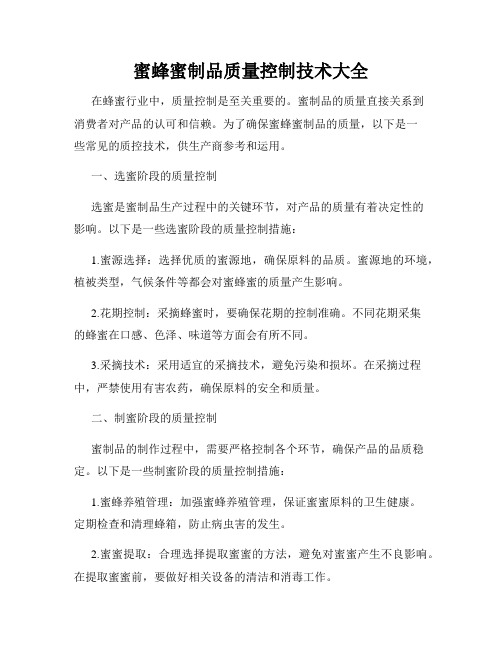
蜜蜂蜜制品质量控制技术大全在蜂蜜行业中,质量控制是至关重要的。
蜜制品的质量直接关系到消费者对产品的认可和信赖。
为了确保蜜蜂蜜制品的质量,以下是一些常见的质控技术,供生产商参考和运用。
一、选蜜阶段的质量控制选蜜是蜜制品生产过程中的关键环节,对产品的质量有着决定性的影响。
以下是一些选蜜阶段的质量控制措施:1.蜜源选择:选择优质的蜜源地,确保原料的品质。
蜜源地的环境,植被类型,气候条件等都会对蜜蜂蜜的质量产生影响。
2.花期控制:采摘蜂蜜时,要确保花期的控制准确。
不同花期采集的蜂蜜在口感、色泽、味道等方面会有所不同。
3.采摘技术:采用适宜的采摘技术,避免污染和损坏。
在采摘过程中,严禁使用有害农药,确保原料的安全和质量。
二、制蜜阶段的质量控制蜜制品的制作过程中,需要严格控制各个环节,确保产品的品质稳定。
以下是一些制蜜阶段的质量控制措施:1.蜜蜂养殖管理:加强蜜蜂养殖管理,保证蜜蜜原料的卫生健康。
定期检查和清理蜂箱,防止病虫害的发生。
2.蜜蜜提取:合理选择提取蜜蜜的方法,避免对蜜蜜产生不良影响。
在提取蜜蜜前,要做好相关设备的清洁和消毒工作。
3.过滤和净化:将提取的蜜蜜进行过滤,去除杂质和异物。
过滤过程中,要确保使用纯净的过滤设备,避免二次污染。
4.熬炼控制:控制蜜蜜的熬炼温度和时间,确保蜜蜜的营养成分和品质不受损害。
三、包装质量控制包装环节是蜜蜂蜜制品出厂前的最后一道工序,不仅关系到产品的外观质量,还关系到产品的保鲜和卫生。
以下是一些包装质量控制措施:1.包装材料:选择符合卫生标准的包装材料,确保产品的安全性和卫生性。
纸盒、瓶子等包装材料应符合食品级别的标准。
2.包装工艺:控制包装工艺,确保包装过程中不受污染和损坏。
封口严密,避免氧气、湿气和异物的进入。
3.包装标签:标示清晰的包装标签,包括产品名称、规格、生产日期、保质期等信息。
确保消费者能够了解到产品的相关信息。
四、质量检测技术为了确保蜜蜂蜜制品的质量,质量检测是必不可少的环节。
蜂蜜加工流程及操作要点

蜂蜜加工流程及操作要点蜂蜜是一种常见且受欢迎的食品,它不仅具有甜美的味道,还有许多益处。
然而,要制作出高质量的蜂蜜,需要经过一系列的加工流程和注意事项。
蜂蜜的加工流程始于采集蜜蜂从花朵中收集的花蜜。
蜜蜂会将花蜜带回蜂巢,然后通过咀嚼和混合花蜜与唾液,将其转化为蜂蜜。
在这个过程中,蜜蜂会通过振动翅膀来蒸发和去除多余的水分,使蜂蜜的水分含量低于20%。
一旦蜂蜜成熟,就需要进行收获和提取的过程。
首先,蜜蜂养殖人员会使用专门的工具将蜂巢中的蜜蜂挤压出来。
然后,蜜蜂会被分离出来,使得蜂蜜可以流出。
这个过程需要小心,以免伤害蜜蜂或污染蜂蜜。
接下来,蜂蜜需要过滤以去除其中的杂质和蜜蜡。
这通常通过将蜂蜜倒入过滤网中来实现。
过滤网的孔径通常很小,可以过滤掉大部分的杂质和蜜蜡,使蜂蜜更加纯净。
在过滤完成后,蜂蜜需要进行加热和搅拌。
加热的目的是杀死可能存在的细菌和微生物,同时还可以提高蜂蜜的流动性。
搅拌的目的是使蜂蜜的颜色更加均匀,并防止结晶。
在这个过程中,需要控制加热的温度和时间,以免对蜂蜜的质量产生不良影响。
加工完成后,蜂蜜需要进行蜜糖分离。
这是为了去除蜂蜜中的沉淀物和空气泡。
分离的过程通常通过离心机来实现。
离心机的旋转力可以将杂质和空气泡从蜂蜜中分离出来,使蜂蜜更加清澈。
蜂蜜需要进行灌装和包装。
蜂蜜通常是以玻璃瓶或塑料瓶的形式进行包装。
在灌装过程中,需要确保容器是干净的,并且密封良好,以防止蜂蜜受到污染和氧化。
在整个加工流程中,有几个操作要点需要特别注意。
首先,要保持卫生和清洁。
加工蜂蜜的环境和设备应该保持清洁,并定期进行清洗和消毒。
其次,要保持适当的温度和湿度。
蜂蜜加工过程中的温度和湿度应该控制在适当范围内,以确保蜂蜜的质量和保存时间。
此外,要确保操作人员具有良好的卫生习惯,并采取适当的防护措施,如戴手套和口罩。
总的来说,蜂蜜的加工流程需要经过采集、提取、过滤、加热、搅拌、分离、灌装和包装等多个环节。
在操作过程中,需要注意卫生和清洁,控制温度和湿度,以及保护蜂蜜免受污染和氧化。
蜜蜂蜂产品加工与质量控制技术大全

蜜蜂蜂产品加工与质量控制技术大全蜂产品加工对于蜜蜂养殖业来说至关重要。
在蜂产品加工过程中,质量控制技术的应用则能够保证蜂产品的质量,提高市场竞争力。
本文将介绍蜜蜂蜂产品加工与质量控制技术的全面知识。
一、蜜蜂蜂产品加工1. 蜂蜜加工蜂蜜是蜂产品中最重要的一种,其加工技术包括:(1)采蜜:选择蜜蜂喜好采集花蜜的植物,并控制时机进行采集。
(2)提取蜜蜂:将采集到的蜜蜂放置在提蜜器中,利用离心力分离蜜蜂进而提取蜜蜂。
(3)过滤:通过过滤器去除杂质和蜜蜂结晶,保证蜜蜂的纯度和口感。
(4)杀菌:蜜蜂具有一定的抗菌能力,但为了确保蜂蜜的安全和保质期,可以在加工过程中进行杀菌处理。
(5)装瓶:将处理好的蜂蜜装入瓶中,并封口保存。
2. 蜂胶加工蜂胶是蜜蜂常常用于修补蜂巢的物质,其加工技术包括:(1)收集蜂胶:定期收集蜂巢上的蜂胶,注意保证收集的蜂胶纯度。
(2)提取蜂胶:将收集到的蜂胶置于提取器中,利用低温或溶剂提取技术进行提取。
(3)过滤:经过提取的蜂胶中可能存在杂质,通过过滤器进行过滤。
(4)干燥:将过滤好的蜂胶进行干燥处理,使其更易于保存和使用。
(5)包装:将处理好的蜂胶进行包装,确保其质量和安全性。
3. 蜂花粉加工蜂花粉是蜜蜂采集花粉带回蜂巢储存的物质,其加工技术包括:(1)收集蜂花粉:定期收集蜂巢上的蜂花粉,注意保证收集的蜂花粉干燥且没有杂质。
(2)清洗:进行蜂花粉的清洗处理,去除附着在蜂花粉上的杂质和微生物。
(3)干燥:将清洗好的蜂花粉进行干燥处理,使其更易于保存和使用。
(4)包装:将处理好的蜂花粉进行包装,确保其质量和安全性。
二、蜜蜂蜂产品质量控制技术1. 原材料选择蜂产品加工的质量控制首先需要选择优质的原材料,如蜜蜂采集的花蜜、蜂胶和蜂花粉等。
原材料的选择应具备纯度高、新鲜度好、无污染等特点。
2. 温度控制加工过程中的温度控制对蜂产品的质量起着重要作用。
不同的蜂产品加工过程中,需要控制不同的温度,如蜂蜜需要保持适宜的提取温度,蜂胶和蜂花粉需要控制低温干燥等。
蜂蜜的质量控制与保证技术大全
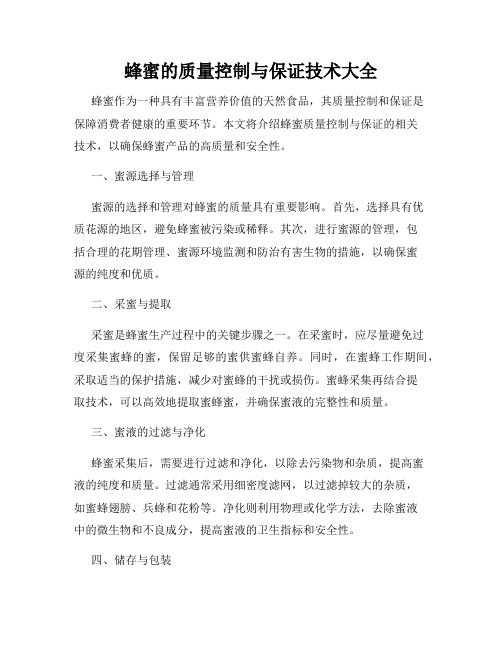
蜂蜜的质量控制与保证技术大全蜂蜜作为一种具有丰富营养价值的天然食品,其质量控制和保证是保障消费者健康的重要环节。
本文将介绍蜂蜜质量控制与保证的相关技术,以确保蜂蜜产品的高质量和安全性。
一、蜜源选择与管理蜜源的选择和管理对蜂蜜的质量具有重要影响。
首先,选择具有优质花源的地区,避免蜂蜜被污染或稀释。
其次,进行蜜源的管理,包括合理的花期管理、蜜源环境监测和防治有害生物的措施,以确保蜜源的纯度和优质。
二、采蜜与提取采蜜是蜂蜜生产过程中的关键步骤之一。
在采蜜时,应尽量避免过度采集蜜蜂的蜜,保留足够的蜜供蜜蜂自养。
同时,在蜜蜂工作期间,采取适当的保护措施,减少对蜜蜂的干扰或损伤。
蜜蜂采集再结合提取技术,可以高效地提取蜜蜂蜜,并确保蜜液的完整性和质量。
三、蜜液的过滤与净化蜂蜜采集后,需要进行过滤和净化,以除去污染物和杂质,提高蜜液的纯度和质量。
过滤通常采用细密度滤网,以过滤掉较大的杂质,如蜜蜂翅膀、兵蜂和花粉等。
净化则利用物理或化学方法,去除蜜液中的微生物和不良成分,提高蜜液的卫生指标和安全性。
四、储存与包装蜂蜜的储存和包装环节对保证蜂蜜质量起着重要作用。
首先,蜂蜜应储存在干燥、阴凉、避光和通风的环境中,避免受潮和阳光直射。
其次,选择合适的容器和包装材料,避免蜜蜡和塑料等材料对蜂蜜的污染。
同时,在包装过程中,应注意封口牢固和卫生条件,防止细菌或氧气的侵入。
五、质量检测与监控蜂蜜质量的检测与监控是确保蜂蜜符合食品卫生标准的重要手段。
常用的蜂蜜质量检测指标包括含水量、氢氧化值、总酸度、重金属含量和微生物指标等。
通过建立质量检测和监控机制,可以提前发现和解决蜂蜜质量问题,确保蜂蜜产品的安全和优质。
六、食品安全生产管理为了确保蜂蜜质量的安全性和可追溯性,食品安全生产管理是必不可少的一环。
生产企业应按照相关食品安全法律法规和标准,建立健全的生产管理制度,包括从原材料采购、生产加工到产品销售的全程管理。
同时,加强对从源头到消费者的全程追溯,确保蜂蜜产品的质量和安全。
蜂产品加工工艺与技术大全
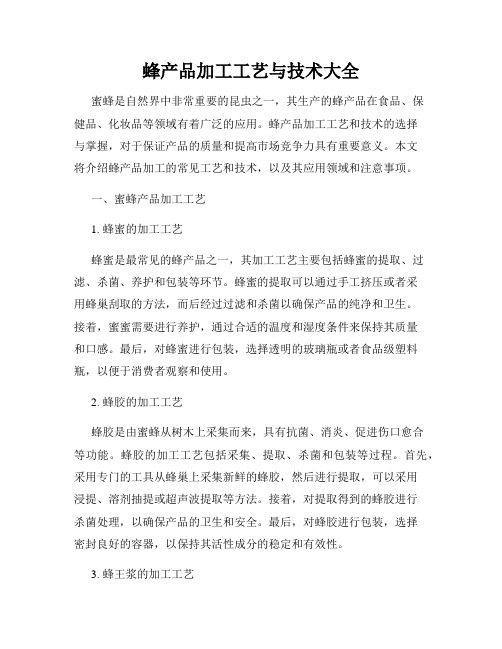
蜂产品加工工艺与技术大全蜜蜂是自然界中非常重要的昆虫之一,其生产的蜂产品在食品、保健品、化妆品等领域有着广泛的应用。
蜂产品加工工艺和技术的选择与掌握,对于保证产品的质量和提高市场竞争力具有重要意义。
本文将介绍蜂产品加工的常见工艺和技术,以及其应用领域和注意事项。
一、蜜蜂产品加工工艺1. 蜂蜜的加工工艺蜂蜜是最常见的蜂产品之一,其加工工艺主要包括蜂蜜的提取、过滤、杀菌、养护和包装等环节。
蜂蜜的提取可以通过手工挤压或者采用蜂巢刮取的方法,而后经过过滤和杀菌以确保产品的纯净和卫生。
接着,蜜蜜需要进行养护,通过合适的温度和湿度条件来保持其质量和口感。
最后,对蜂蜜进行包装,选择透明的玻璃瓶或者食品级塑料瓶,以便于消费者观察和使用。
2. 蜂胶的加工工艺蜂胶是由蜜蜂从树木上采集而来,具有抗菌、消炎、促进伤口愈合等功能。
蜂胶的加工工艺包括采集、提取、杀菌和包装等过程。
首先,采用专门的工具从蜂巢上采集新鲜的蜂胶,然后进行提取,可以采用浸提、溶剂抽提或超声波提取等方法。
接着,对提取得到的蜂胶进行杀菌处理,以确保产品的卫生和安全。
最后,对蜂胶进行包装,选择密封良好的容器,以保持其活性成分的稳定和有效性。
3. 蜂王浆的加工工艺蜂王浆是蜜蜂分泌的乳状物质,富含蛋白质、氨基酸和维生素等营养物质,具有抗衰老、增强免疫力等功效。
蜂王浆的加工工艺主要包括收集、提取、杀菌和包装等步骤。
首先,选择合适的时间和方法收集新鲜的蜂王浆,可以采用人工收集或者利用蜂王笼收集的方法。
然后,对蜂王浆进行提取,可采用离心、超滤或凝胶过滤等技术,以去除杂质和浓缩蜂王浆中的营养成分。
之后,对提取得到的蜂王浆进行杀菌处理,以确保产品的安全和卫生。
最后,对蜂王浆进行密封包装,选择食品级的容器,以保持产品的新鲜度和功效。
二、蜂产品加工技术1. 温度控制技术在蜂产品的加工过程中,温度控制是非常重要的一环。
不同的蜂产品具有不同的温度要求,合理控制加热和冷却的温度可以保证产品的品质和口感。
蜜蜂蜜的生产工艺与质量控制要点揭秘
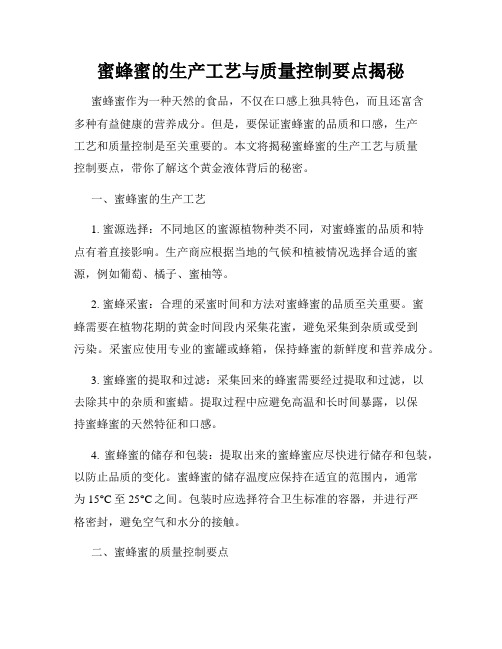
蜜蜂蜜的生产工艺与质量控制要点揭秘蜜蜂蜜作为一种天然的食品,不仅在口感上独具特色,而且还富含多种有益健康的营养成分。
但是,要保证蜜蜂蜜的品质和口感,生产工艺和质量控制是至关重要的。
本文将揭秘蜜蜂蜜的生产工艺与质量控制要点,带你了解这个黄金液体背后的秘密。
一、蜜蜂蜜的生产工艺1. 蜜源选择:不同地区的蜜源植物种类不同,对蜜蜂蜜的品质和特点有着直接影响。
生产商应根据当地的气候和植被情况选择合适的蜜源,例如葡萄、橘子、蜜柚等。
2. 蜜蜂采蜜:合理的采蜜时间和方法对蜜蜂蜜的品质至关重要。
蜜蜂需要在植物花期的黄金时间段内采集花蜜,避免采集到杂质或受到污染。
采蜜应使用专业的蜜罐或蜂箱,保持蜂蜜的新鲜度和营养成分。
3. 蜜蜂蜜的提取和过滤:采集回来的蜂蜜需要经过提取和过滤,以去除其中的杂质和蜜蜡。
提取过程中应避免高温和长时间暴露,以保持蜜蜂蜜的天然特征和口感。
4. 蜜蜂蜜的储存和包装:提取出来的蜜蜂蜜应尽快进行储存和包装,以防止品质的变化。
蜜蜂蜜的储存温度应保持在适宜的范围内,通常为15°C至25°C之间。
包装时应选择符合卫生标准的容器,并进行严格密封,避免空气和水分的接触。
二、蜜蜂蜜的质量控制要点1. 外观和颜色:蜜蜂蜜的外观应该清澈透明,没有浮游物或悬浮物。
颜色应符合蜜源植物的特征,例如葡萄蜜的颜色为浅黄色。
2. 水分含量:蜜蜂蜜的水分含量是判断其质量的重要指标。
通常,水分含量低于20%的蜂蜜会更加稳定耐久。
生产商应使用专业的工具进行测量,并确保蜜蜂蜜符合卫生标准。
3. pH值和酸度:蜜蜂蜜的pH值和酸度可以反映其抗菌性和新鲜度。
正常的蜂蜜pH值应在3.2至4.5之间,酸度不超过0.4%。
生产商可以通过化学检测方法进行测试,确保蜜蜂蜜符合标准。
4. 酶活性:蜜蜂蜜中的酶活性可以衡量其营养价值和抗氧化性。
通常,较高的酶活性表示蜜蜂蜜更加纯正和有机。
生产商可以通过专业的检测方法检测蜂蜜的酶活性,并与相关的标准进行对比。
- 1、下载文档前请自行甄别文档内容的完整性,平台不提供额外的编辑、内容补充、找答案等附加服务。
- 2、"仅部分预览"的文档,不可在线预览部分如存在完整性等问题,可反馈申请退款(可完整预览的文档不适用该条件!)。
- 3、如文档侵犯您的权益,请联系客服反馈,我们会尽快为您处理(人工客服工作时间:9:00-18:30)。
蜂蜜生产加工工艺流程与关键质量控制点
技术
The production and processing of honey involve several key steps to ensure its quality. In this response, we will outline the general process and highlight important quality control points throughout.
Firstly, it is crucial to start with the selection of high-quality raw materials. Beekeepers should choose healthy beehives in areas free from pollution and pesticides. The flowers visited by bees affect the taste and aroma of honey, so selecting a diverse range of flowering plants is essential.
Raw honey extraction is the next step. Beekeepers carefully remove frames from the hives that contain capped honeycombs. These frames are then uncapped using a hot knife or other suitable tools. After uncapping, beekeepers often use an extractor to spin these frames, extracting liquid honey through centrifugal force.
Once extracted, the honey goes through a filtration process to remove impurities such as beeswax and pollen particles. Filtration can be done using stainless steel sieves or
nylon filters. It is important to note that excessive filtration can strip away beneficial compounds present in raw honey, so striking a balance between clarity and retaining natural components is crucial.
After filtration, the honey needs to be properly stored in clean containers. Glass jars or food-grade plastic containers are commonly used for packaging. Proper labeling with information regarding production date, origin, and any additives (if applicable) should be included on the package.
Quality control throughout the entire production process is vital for ensuring product safety and consistency. Monitoring key parameters like moisture content, acidity level (pH), and absence of contaminants such as antibiotics or heavy metals is crucial at critical control points. Microbiological analysis should also be conducted regularly to check for pathogens such as yeast or bacteria.
Additionally, regular testing for adulteration is essential to maintain product integrity. Honey adulteration involves mixing pure honey with cheaper sugars like corn syrup or rice syrup. Various analytical techniques like nuclear magnetic resonance spectroscopy can detect sugar profiles specific to different types of honey and identify any adulteration.
In summary, the production and processing of honey involve careful selection of raw materials, proper extraction techniques, filtration to remove impurities while preserving natural compounds, appropriate packaging, and stringent quality control measures. By following these guidelines and ensuring adherence to key quality control points throughout the process, the industry can maintain high-quality honey production while meeting consumer demands.
中文翻译:
蜂蜜的生产和加工过程涉及几个关键步骤,以确保其质量。
在本回答中,我们将概述一般的流程,并在其中强调重要的质量控制点。
选择高质量的原材料非常重要。
养蜂人应选择健康的蜂群,并在没有污染和农药的地区饲养。
被蜜蜂访问的花朵会影响蜂蜜的口感和香气,因此选择多种开花植物是必要的。
接下来是原始蜂蜜提取。
养蜂人仔细从蜂房中取出含有已封闭巢板的框架。
然后使用热刀或其他合适的工具去盖巢板。
解除盖子后,养蜂人经常使用离心机旋转这些框架,通过离心力提取液态蜂蜜。
提取后,蜂蜜经过过滤处理以去除蜜蜡和花粉颗粒等杂质。
可以使用不锈钢筛子或尼龙过滤器进行过滤。
值得注意的是,过度过滤可能会剥夺原始蜂蜜中存在的有益化合物,因此,在清晰度和保留天然成分之间找到平衡非常重要。
过滤后,需要将蜂蜜正确地存放在干净的容器中。
通常使用玻璃罐或食品级塑料容器进行包装。
包装上应标明生产日期、产地信息以及任何添加剂(如果适用)。
在整个生产过程中进行质量控制非常重要,以确保产品的安全性和一致性。
在关键控制点上监测水分含量、酸度水平(pH值)以及抗生素或重金属等污染物的不存在是至关重要的。
还应定期进行微生物分析,检查是否存在酵母菌或细菌等病原体。
定期检测是否被掺假是保持产品完整性所必需的。
掺假蜂蜜涉及将
纯蜂蜜与更便宜的糖(如玉米糖浆或米糖浆)混合。
各种分析技术,如核磁共振光谱法,可以检测特定于不同类型蜂蜜的糖的成分,并
确定是否有任何掺假。
蜂蜜的生产和加工过程需要仔细选择原材料,使用适当的提取技术,过滤以去除杂质并保留天然化合物,适当包装以及严格的质量控制
措施。
通过遵循这些准则,并确保在整个过程中遵守关键的质量控
制点,该行业可以保持高质量的蜂蜜生产,并满足消费者需求。
